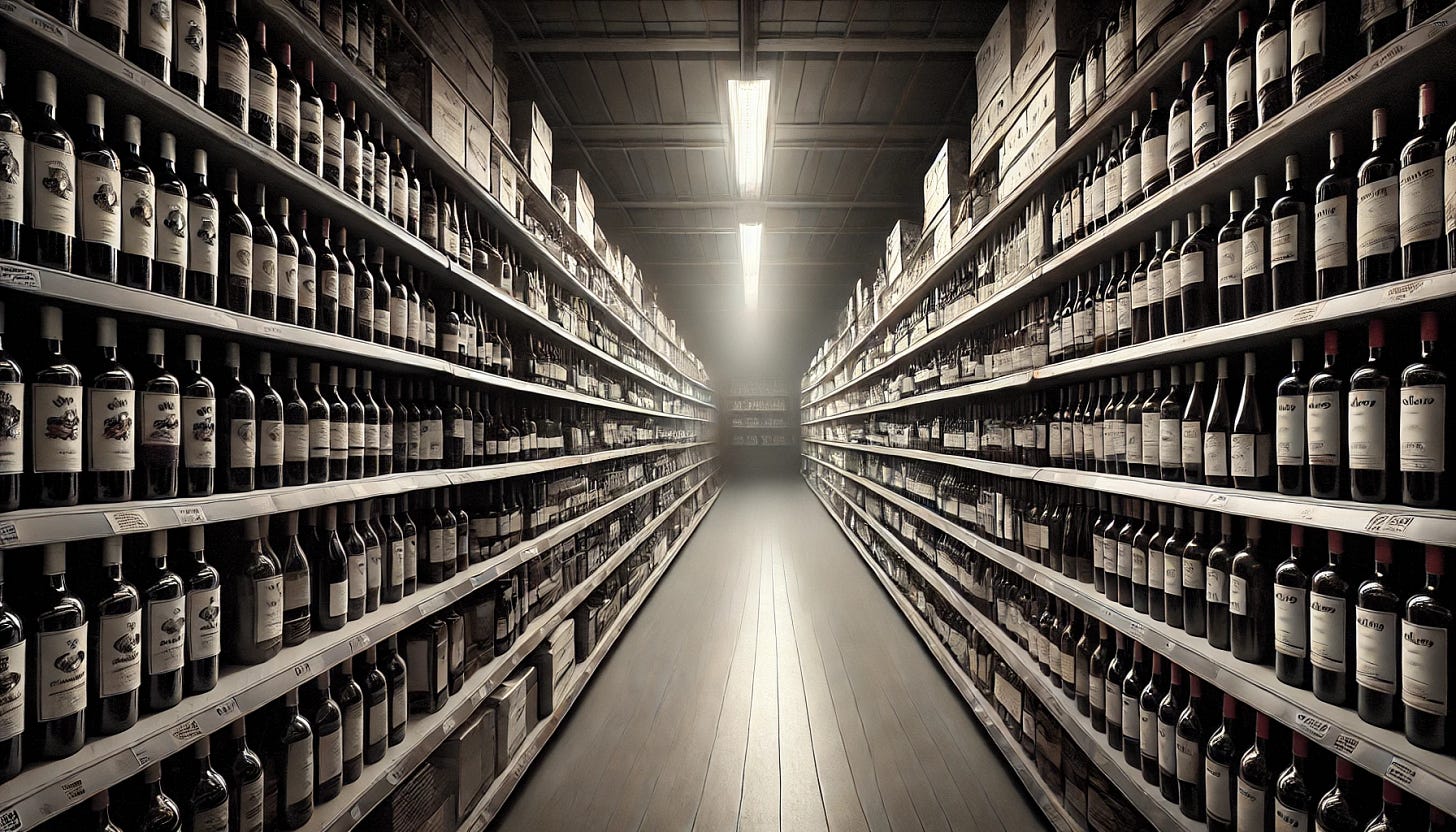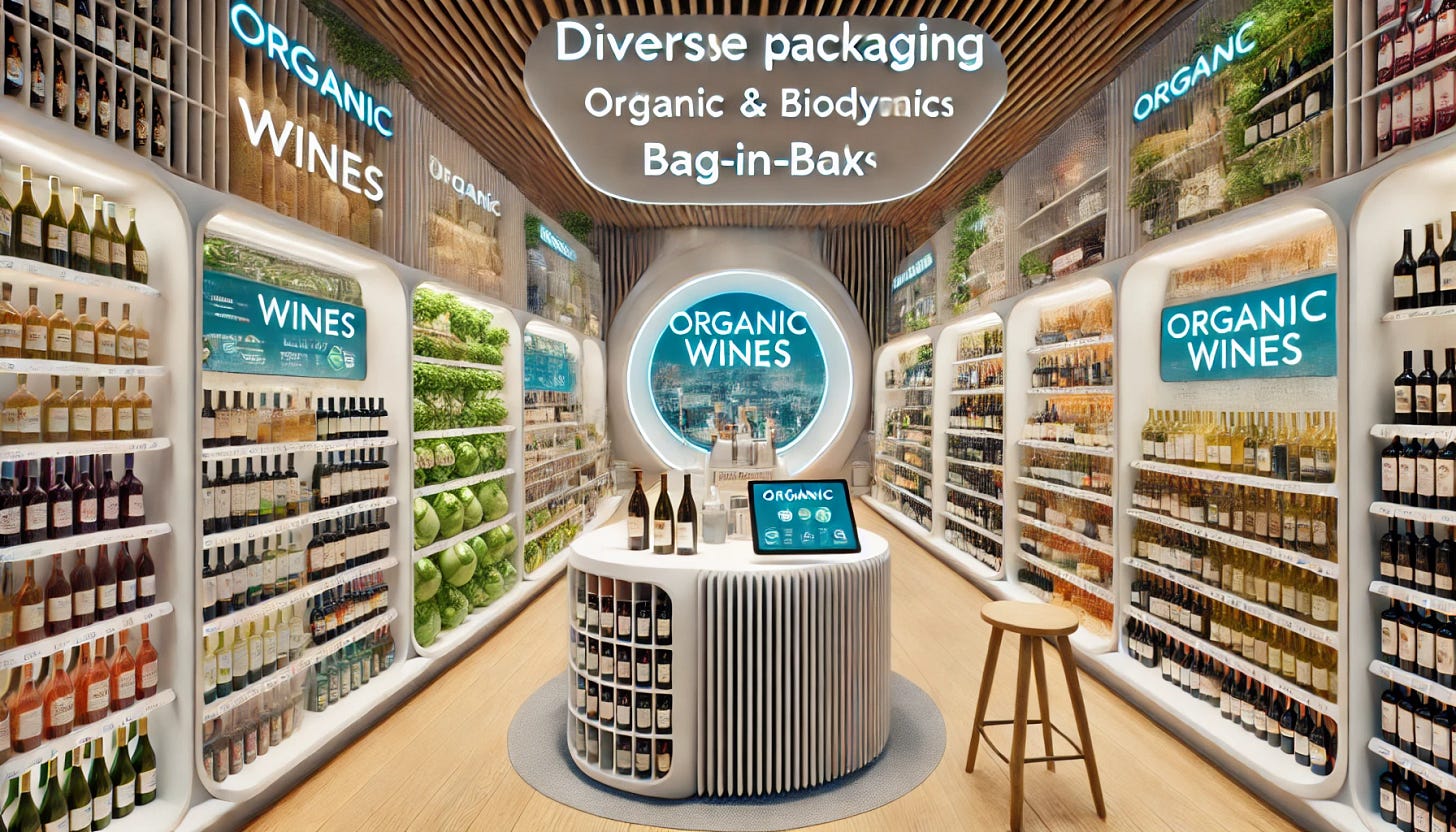Behind the Bottle - The Wine Aisle of 2029
My take on the potential future of the supermarket wine shelf
Plunge your mind back to 2019 (if you dare).
You’re standing in a supermarket wine aisle, much like the one below.
Does it look much different from what you would find if you walked into a supermarket right now?
Sure, the prices might be a little lower, and you won’t see quite so many celebrity-endorsed labels, but overall, you could be forgiven for thinking you hadn’t travelled back in time at all.
The wine world currently stands at a crossroads, desperate for a shake-up. With this in mind, I’ve decided to embark on a whimsical journey to show you what could be the future of the supermarket wine aisle in 2029 from three different perspectives.
The Pessimist's Vision
Dominance of Mass-Produced Brands: Conglomerates and big-name brands continue to tighten their grip on the market, pushing out smaller, artisanal producers. The shelves are packed with generic, uniform bottles that lack any real character or soul.
Homogenisation of Taste: With profitability placed above quality, winemakers focus on consistency and predictability. The result? Increasingly standardised wines offer little variation in taste or style. Diversity gives way to monotony, with the same familiar grape varieties and regions dominating the scene.
Celebrity Wine Takeover: The trend of celebrity-endorsed wines is a worrying one, where famous names continue to overshadow genuine craftsmanship and expertise. Armed with marketing clout and star power, these wines dominate the shelves, pushing lesser-known gems into the shadows — even politicians have their faces on bottles.
Tax ‘Non’ Efficient: Thanks to a convoluted duty system, supermarkets buy based on price rather than product. The result is a compromise on quality.
Honey, I Shrunk the Wine Aisle: The wine aisle continues to lose ground to other categories, and its space slowly but surely diminishes.

The Hopeful's Vision
Sustainability and Eco-Friendliness Take the Lead: Organic, biodynamic, and natural wines have moved to centre stage, capturing the interest of environmentally conscious consumers. Shoppers are encouraged to bring their own bottles or containers, creating a community dedicated to reducing packaging waste.
Emphasis on Transparency: Wineries are now expected to openly share detailed information about ingredients, additives, and production methods, empowering consumers to make well-informed choices.
Rise of Alternative Formats: Beyond refillable bottles, alternative packaging formats like cans, Tetra Paks, and bag-in-box are gaining traction. These options offer convenience and affordability, appealing to a wider range of wine drinkers.
Low and No: This category now works alongside the range offering great alternatives and stepping stones into the world of wine.

The Optimist's Vision
Expanded Selection: The wine aisle of the future presents a broader and more enticing selection than ever before. From classic varietals to daring experimental blends, consumers are truly spoilt for choice. The shelves are alive with an eclectic mix.
A blend of Tradition and Modernity: Striking a balance between the old and the new, the wine aisle becomes a dynamic fusion of traditional and contemporary winemaking practices. While classic methods are respected and maintained, innovative approaches — like sustainable farming techniques and cutting-edge fermentation technologies — add a refreshing twist to the wine world.
Showcase of Artisanal Producers: Small-scale, artisanal producers finally take centre stage, bringing unique selections to each store. Shoppers have the chance to explore handcrafted wines from boutique wineries, with each bottle offering a narrative of passion, craftsmanship, and a true sense of place linking up with independents and British producers.
Cultivation of Community: Wine shopping transforms into a communal experience, with tastings, workshops, and events that build connections between producers, retailers, and consumers. Local wine clubs and online forums provide spaces for enthusiasts to share knowledge, recommendations, and their passion for wine.
A New Look: The wine section looks and feels more sleek and modern making it stand out from all of the other aisles. It is a place of excitement and opportunity.
Independents Benefit: This wave of excitement leads to customers heading out to their local wine shop with a first to discover more. Wine has shaken its stuffy reputation and stands out as an exciting category with the mantra of “Drink less, drink better.” at the forefront.

Conclusion
The wine aisle has become a critical battleground for supermarkets. After closely observing their tactics over the past four years, it's clear that enticing bank holiday offers are meant to lure us in to buy our beans alongside our Beaujolais. While this has begun to shift the choices on our shelves for the better, change is slow.
My greatest hope is for supermarkets to reimagine this space—to inspire deeper wine knowledge and passion, champion local and smaller producers, and spark curiosity that encourages people to explore independent shops and elevate their wine game.
What I do know is that if the wine aisle of 2029 looks like it did in 2019, I’ll probably be in a different industry.
Drink less, drink better.
Cheers,
Luke
I’d love to hear if you're a pessimist, a hopeful, or an optimist in the comments section below.







Call me a pessimist and optimist! Supermarkets operate on standardisation, brands, and just-in-time supply chains, which unfortunately, leaves little room for smaller producers and unique varieties. Supermarket shelves are valuable real estate that are either reserved for those products they know will sell in volume, or those who are willing to pay to be there. It's the harsh reality which won't be changing...
So, here lies the opportunity for specialists, indies and online. Customers want experiences, variety and good quality. The challenge for these smaller retailers is appealing to a wider audience, providing good value and genuine service. Supermarkets just want you to buy (along with your eggs and bread), they're not interested in providing an education or specialised service, and there is no incentive to do so. The only supermarkets who buck this trend are Aldi & Lidl, as they are not tied to any brands and can order in smaller parcels that they can sell for a low price.
However, if wine is to grow and become beloved by more people, the future growth surely lies beyond the supermarket shelves.